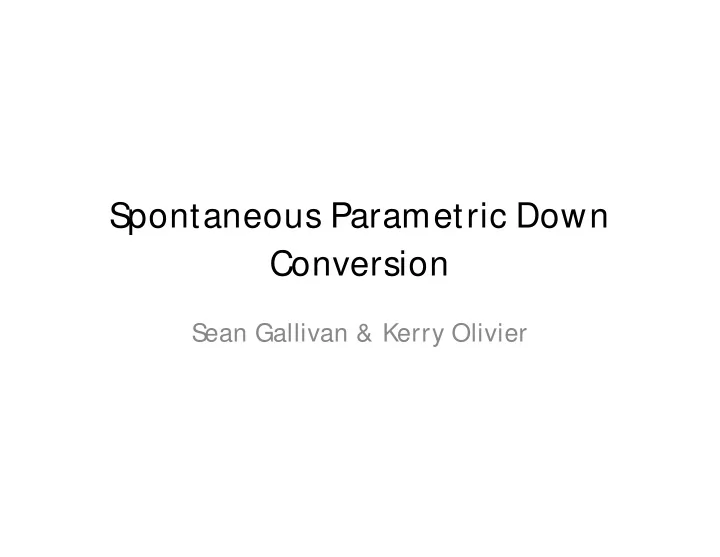

Spontaneous Parametric Down Conversion Sean Gallivan & Kerry Olivier
General Overview Conservation of Energy: Conservation of M omentum:
Why is it called SPDC? • Spontaneous: Generated by quantum vacuum fields • Parametric: Phase relationship between input and output fields • Down Conversion: Signal & Idler frequencies are lower than pump
Why Should I Care? • Production of single photons • Photon entanglement is ripe for quantum information experiments • It ’s cool!
Lab Setup to Investigate SPDC
Results of SPDC Investigation Coincidence Counts as Leg A is Held Constant and Leg B is Swept 1345 Coincidence Counts/ Second 1145 945 745 545 345 145 1.5 2 2.5 3 3.5 4 4.5 B Angle (Degrees)
Gaussian Fit of Data Coincidences AB 1200 1000 800 600 400 200 Angle ° 2.0 2.5 3.0 3.5 4.0
M easurement of
Results • Best measurement: = .713 Standard Deviation = .0123 >23 Standard Dev.’s below 1 (10 measurements, 10s per measurement) • Worst measurement: = .702 Standard Deviation = .052402 >5 Standard Dev.’s Below 1 (10 measurements, 1s per measurement)
Single Photon Interference
Results of Single Photon Interference Single Photon Interference In a Quantum Eraser (θ 1 = 38°, V = 81.9%) 2000 1800 Coincidence Counts 1600 1400 1200 1000 800 600 AB 400 AB' 200 0 0 0.00005 0.0001 0.00015 0.0002 0.00025 0.0003 Angular Displacement of BDP
Visibility of Interference Patterns & Quantum Erasers • θ 1 = 38°, Visibility = 81.9%, Expected g2 = .24 (SD = .42) • θ 1 = 10°, Visibility = 30.2%, Expected g2 = .24 (SD = .36) • θ 1 = 0° , Visibility = 31.4%, Expected g2 = .24 (SD = .29) • θ 3 = 0°, Visibility = 17.5%, Expected g2 = .24 (SD = .16)
Local Realism • Locality : A measurement in one location cannot affect a measurement performed elsewhere • Reality : ‘real’ objects have measurable quantities regardless of if we look at them or not
Bell’s Inequality & T esting Local Realism • Joint probability of photons polarized in 2 directions: • Bell-Clauser-Horne Inequality:
Attempted Local Realism Setup
New Equipment for Local Realism • Paired BBO • Berek Compensator Retardance Indicator : How much retardance to apply Orientation Dial : Rotates housing (orienting the slow axis of the compensator plate)
M inimizing Noise
Clothing makes a big difference
Future Project Plans • Labview Programming for Local Realism/obtain motorized waveplates • Find optimal density filter attenuation • Get 4 of the same density filters • Find some way of better regulating A’ and B’ leg angles (they swivel too easily) • Set up a curtain to pull back and forth across the white board
Questions?
M ore on SPCD & BBOs • Angle of down converted photon emission is defined by orientation of optical axis of BBO with respect to the orthogonal face • BBO emits down conversion photons in a cone (for type I down conversion)
Piezo Actuators
Calculating Angular Displacement Beam separation as a function of optical axis angle theta and block length D
Beam Displacement Polarizers
‘Interference’ Without Quantum Erasure Interference Pattern With No Quantum Single Photon Interference With Little Erasure (θ 1 = 10°, V = 30.2%) Quantum Erasure (θ 1 = 0°, V = 31.4%) 1400 1400 Coincidence Counts Coincidence Counts 1200 1200 1000 1000 AB 800 800 AB AB' 600 600 AB' 400 400 0 0.00005 0.0001 0.00015 0.0002 0.00025 0.0003 0 0.0001 0.0002 0.0003 0.0004 0.0005 Angular Displacement of BDP Angular Displacement of BDP Interference Pattern With No Quantum Erasure (θ 3 = 0°, V = 17.5%) 6500 Coincidence Counts 6000 5500 5000 4500 AB 4000 AB' 3500 3000 0 0.0001 0.0002 0.0003 0.0004 0.0005 0.0006 Angular Displacement of BDP
Avalanche Photodiodes • Utilizes photoelectric effect • Impact ionization allows for small signal detection (i.e. single photons) due to ‘self- sustaining avalanche’ with current in mAs • This current is then subsided by lowering bias voltage down to breakdown voltage
Entangled States • Assuming pump is at 45 degrees & BBO pairs are sufficiently close together: 2 photon pairs are indistinguishable • Thus we must consider them to be superpositions of both possible polarizations:
Individual & Joint Probabilities • If 2 photons are in entangled state, then measurements made on 1 photon are random • M easurements made on pairs of photons will be perfectly correlated
Labview Woes
Labview Woes Cont’d
Overview of Troubleshooting Processes Testing to see if you're even getting down conversion: • Try blocking the path down converted photons would take right after the crystal: if the number decreases you are seeing down conversion, if it remains the same you are not • for experiments other than 1, try rotating the waveplate: down converted light will oscillate back and forth, noise will remain constant • try turning the pump off and on and simply look at how much of a difference you get If you're getting 0 for any detection or coincidence, something is wrong. • Check to see if all the detectors are on (on the front panel) • Check the fpga switches
Recommend
More recommend